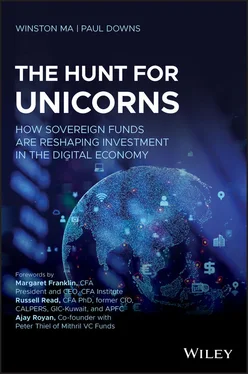Unlike orthodox pension funds, the assets they manage remain the property of the government and no individual has any claim on them. The liability stream goes to the government and then the government deploys the capital on behalf of the people. As a result, these funds can remain long-term investors even as they are drawn upon. Proceeds from a government privatization may conveniently be parked in a fund to provide funds for specified future needs or simply to keep them out of the hands of the politicians. They can feature among the most transparent funds.
For two, sovereign pension funds. The difference from the former is the liability stream. With a sovereign pension fund, the liability flows directly to the constituents of the fund. The Canadian government employee pension funds like CPPIBare good examples of the latter. They seek a rate of return that will enable them to meet their pension obligations to their members. They balance outflows to fund pension payouts with employer and employee contributions supplemented by their returns from investments. While longer term investors than private equity or venture capital funds, they must take into account actuarial liabilities, hence are often more limited than the intergenerational or pension guarantee funds such as NZ Super or Future Fund.
In North America, one sovereign fund with the management of pensions assets among its assigned tasks has taken on its superhero rescue mission. Dealing with the impact of the pandemic on the local economy, Quebec's Caisse de Depot et Placement du Quebec (CDPQ)in early 2020 created a C$4 billion fund to support Quebec companies adversely affected by the corona virus, whether or not they are in its portfolio. This program was quickly introduced to enable the recipient companies to survive the pandemic and underpin the recovery of the local economy. Before that, CDPQ was already deeply involved in Quebec's development; one major project is a C$6 billion high-speed, light-rail network in Montreal connecting with existing transport.
Such innovation – here seen in response to the coronavirus pandemic – is not out of character for public pension funds. Despite being increasingly subject to governance and regulatory obligations – like the global sovereign wealth funds (SWF) – public pension funds (PPF) have constantly braved new territories. Canadian funds are often acknowledged to be among the leaders in new asset classes, such as infrastructure and venture capital, in growing in-house capabilities rather than relying on outside managers, in opening outposts abroad, and in paying competitive compensation to attract talent.
Adding to the rapid ferment of ideas in the world of sovereign investors, PPFs frequently actively co-invest with the sovereign wealth funds. Sovereign Wealth Funds 2018, the report of the IE Foundation, provides a representative sampling of recent PPF/SWF co-investments of $1 billion or more (see Table 1.3 ).
Four Canadian PPFs, CPPIB, British Columbia Investment Management Company (BCI), Ontario Teachers' Pension Plan (OTPP), and Public Sector Pension (PSP)rank high on the league table of sovereign wealth fund co-investors, ahead of others such as Morgan Stanley and Macquarie (the banks having rated only three each). Kuwait's sovereign investor teamed with OTPP and AIMCo (also Canadian) to acquire London's City airport; CPPIB has joint ventured with GIC to acquire and manage student housing; with Temasek, CPPIB also joined in the investment into South Korea's Homeplus, just to name a few. Therefore, this book will cover the sovereign wealth funds (SWF) and public pension funds (PPF) together as “sovereign investment funds” (SIF) and “sovereign investors.”
Table 1.3 Representative Volume of PPF/SWF Co-investments
Data Source: IE Sovereign Wealth Research 2019.
| Pension Fund |
Co-investments with SWFs |
| CPPIB |
6 |
| OTPP |
3 |
| BCI |
3 |
| PSP |
3 |
| (deal size $1 billion minimum) |
|
Big Spenders, ESG Promoters
For decades, sovereign investment funds preferred to remain in the shadows. Little was known about them and their nature as long-term passive investors helped keep it this way. In recent years, however, the nature of sovereign investors has begun to evolve. Alongside accumulating a large and growing pool of capital, once very passive holders of government wealth, sovereign investors have transformed operations in three critical ways: attracting better talent, adding more asset classes, and expanding into active investment strategies.
The Canadian pension funds, for example, have rebalanced to favor direct investments into alternative assets, including tech startups traditionally viewed as out of SIF's comfort zone. For example, at the end of the 1990s, CPPIBinvested close to 100% in Canada; today, that figure is only 15%. The fund is global in its pursuit, placing tech bets in India from its office in Mumbai, among overseas offices in multiple continents. Also headquartered in Toronto, Ontario Municipal Employees Retirement System (OMERS)has established a ventures arm that directly invests in early stage tech companies and has dedicated venture teams in Silicon Valley as well as London. Notably, the Canadians have been savvy players in Washington, successfully lobbying for tax treatment on an equal footing to US pension plans.
Combining big spending on direct investments with promotion of ESG goals, a pair of deep pocketed SIFs, GICand ADIA, have teamed up to back green, sustainable energy in the developing world. Both participated in 2019 in a nearly $500 million equity round to back a pair of green energy projects totaling $2 billion in India. This brings their aggregate investment to $2.2 billion in the issuer, Greenko Holding. With the latest round, Greenko Holding will be developing the two (2.4 GW total) projects, each with wind and solar generation and hydro energy storage. GIC is majority shareholder of Greenko, which holds the record for Asia's largest green bond issuance at $1 billion.
Politics, Ethics, and International Diversification
In a country with a total equity market capitalization of $1.9 trillion (2018), South Korea's nearly $600 billion national pension fund has announced its intention to rebalance its portfolio from about 45% domestic fixed income and 18% domestic equities to 30% and 15%, respectively, while raising overseas equities from 20% to 30%.
Asset managers of the fund – which reports to the cabinet and South Korean parliament – will now have to deal increasingly with the politically charged determination of which Japanese issuers may have engaged in war crimes during the Japanese occupation of Korea. In the face of proposed South Korean legislation that would ban South Korean pension funds from investing in “war crime companies,” the sovereign pension fund has announced a review of its portfolio of more than $1 billion in Japanese equities, the Financial Times has reported.
Of course, cross-border activity is not without baggage. In South Korea, the National Pension Service (NPS)has grown so large that the local markets are simply not deep and wide enough to absorb its moves. When expanding its overseas portfolio, however, the pension fund has faced difficult investment choices due to rising political tensions with Japan (see Box: Politics, Ethics, and International Diversification). In extreme cases, sovereign investors may turn into rogue traders themselves like those in the urban legends of the Wall Street (see Box: 1MDB the Outlier).
Читать дальше












